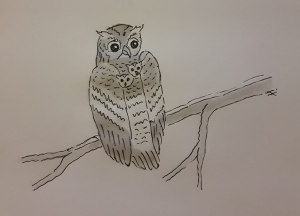Difference between revisions of "Saddle Back Owl"
From World of Entorais Wiki
Jump to navigationJump to search (applied template) |
(content) |
||
| Line 1: | Line 1: | ||
[[File:saddle_back_owl.png|thumb|right|100x|Saddle Back Owl - "Sebastian Romu" © 2019]] | |||
==About== | ==About== | ||
;Common Names: | ;Common Names:Saddle Back Owl | ||
;Classification: | ;Classification:Bird | ||
:The Saddle Back Owl is named for its curious behaviour of actually carrying its young owlets about nestled between its wings. shortly after hatching the mother and one or two young will depart the nest and hunt together. | |||
==Description== | ==Description== | ||
;Size: | ;Size: 1-2 kilograms (3-4 pounds), metres (18-20 inches) height, (30-34 inches) wingspan | ||
;Appearance: | ;Appearance:People best describe these owls as grey with brown speckles, with white banding on the wings and lower back, a pair of feathered white brows, and a worried expression on their face. | ||
;Sexual Dimorphism: | ;Sexual Dimorphism:No obvious difference between the sexes. | ||
;Variance: | ;Variance: No known sub-species | ||
==Ecology== | ==Ecology== | ||
;Habitat: | ;Habitat:Sub-Tropical to Sub-Arctic forests. | ||
;Diet: | ;Diet:Small mammals, birds, and lizards. | ||
==Behaviour== | ==Behaviour== | ||
;Social grouping: | ;Social grouping:Solitary, Mated pair, or mother with one or two young. | ||
;Temperament: | ;Temperament:Wary. | ||
;Intelligence: | ;Intelligence:Animal | ||
;Reproduction: | ;Reproduction:After mating, females will nest in hollows of tall trees, hatching one or two young. These hatchlings spend a significant amount of their pre-flight lives nestled in the thick feathers on the backs of their mothers, tucked between her wings. | ||
==Sub-Species== | ==Sub-Species== | ||
: | :No known sub-species. | ||
==Domestication== | ==Domestication== | ||
;General: | ;General:None. The brooding behaviour of the females makes them unsuitable for training as a hunting bird. | ||
;Resources: | ;Resources:Meat, Eggs, Feathers | ||
==Stories== | ==Stories== | ||
| Line 33: | Line 31: | ||
:<!--List any stories relating to or about this fauna--> | :<!--List any stories relating to or about this fauna--> | ||
</div> | </div> | ||
==See Also== | ==See Also== | ||
:<!--links to related material--> | :<!--links to related material--> | ||
[[Category:Bird]] | [[Category:Bird]] | ||
[[Category:Fauna]] | [[Category:Fauna]] | ||
Revision as of 20:00, 17 February 2020
About
- Common Names
- Saddle Back Owl
- Classification
- Bird
- The Saddle Back Owl is named for its curious behaviour of actually carrying its young owlets about nestled between its wings. shortly after hatching the mother and one or two young will depart the nest and hunt together.
Description
- Size
- 1-2 kilograms (3-4 pounds), metres (18-20 inches) height, (30-34 inches) wingspan
- Appearance
- People best describe these owls as grey with brown speckles, with white banding on the wings and lower back, a pair of feathered white brows, and a worried expression on their face.
- Sexual Dimorphism
- No obvious difference between the sexes.
- Variance
- No known sub-species
Ecology
- Habitat
- Sub-Tropical to Sub-Arctic forests.
- Diet
- Small mammals, birds, and lizards.
Behaviour
- Social grouping
- Solitary, Mated pair, or mother with one or two young.
- Temperament
- Wary.
- Intelligence
- Animal
- Reproduction
- After mating, females will nest in hollows of tall trees, hatching one or two young. These hatchlings spend a significant amount of their pre-flight lives nestled in the thick feathers on the backs of their mothers, tucked between her wings.
Sub-Species
- No known sub-species.
Domestication
- General
- None. The brooding behaviour of the females makes them unsuitable for training as a hunting bird.
- Resources
- Meat, Eggs, Feathers
